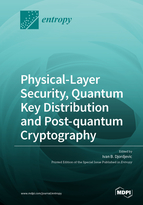Physical-Layer Security, Quantum Key Distribution and Post-quantum Cryptography
A special issue of Entropy (ISSN 1099-4300). This special issue belongs to the section "Quantum Information".
Deadline for manuscript submissions: closed (14 June 2021) | Viewed by 35118
Special Issue Editor
Interests: quantum key distribution; physical-layer security; coding for optical channels; quantum error correction; optical communications and networks; coding for wireless channels; turbo equalization; coded modulation
Special Issues, Collections and Topics in MDPI journals
Special Issue Information
Dear Colleagues,
The growth of data driven technologies, 5G, and Internet pose enormous pressure on underlying information infrastructure. There exist numerous proposals on how to deal with the possible capacity crunch. However, the security of both optical and wireless networks lags behind reliable and spectrally efficient transmission. Significant achievements have been made recently in the quantum computing arena. Because most conventional cryptography systems rely on computational security, which guarantees the security against an efficient eavesdropper for a limited time, with the advancement in quantum computing this security can be compromised. To solve for these problems various schemes providing the perfect/unconditional security have been proposed including physical-layer security (PLS), quantum key distribution (QKD), and post-quantum cryptography. Unfortunately, it is still not clear how to integrate those different proposals with higher level cryptography schemes. So the purpose of this Special Issue is to integrate these various approaches and enable the next generation of cryptography systems whose security cannot be broken by the quantum computers. The topics to be addressed in this Special Issue include:
- Physical-layer security
- Quantum key distribution (QKD)
- Post-quantum cryptography
- Quantum enhanced cryptography
- Stealth communication
- Covert communication
Prof. Dr. Ivan B. Djordjevic
Guest Editor
Manuscript Submission Information
Manuscripts should be submitted online at www.mdpi.com by registering and logging in to this website. Once you are registered, click here to go to the submission form. Manuscripts can be submitted until the deadline. All submissions that pass pre-check are peer-reviewed. Accepted papers will be published continuously in the journal (as soon as accepted) and will be listed together on the special issue website. Research articles, review articles as well as short communications are invited. For planned papers, a title and short abstract (about 100 words) can be sent to the Editorial Office for announcement on this website.
Submitted manuscripts should not have been published previously, nor be under consideration for publication elsewhere (except conference proceedings papers). All manuscripts are thoroughly refereed through a single-blind peer-review process. A guide for authors and other relevant information for submission of manuscripts is available on the Instructions for Authors page. Entropy is an international peer-reviewed open access monthly journal published by MDPI.
Please visit the Instructions for Authors page before submitting a manuscript. The Article Processing Charge (APC) for publication in this open access journal is 2600 CHF (Swiss Francs). Submitted papers should be well formatted and use good English. Authors may use MDPI's English editing service prior to publication or during author revisions.
Keywords
- physical-layer security
- quantum key distribution (QKD)
- continuous variable QKD
- discrete variable QKD
- measurement device independent QKD
- post-quantum cryptography
- quantum enhanced cryptography
- stealth communication
- covert communication







